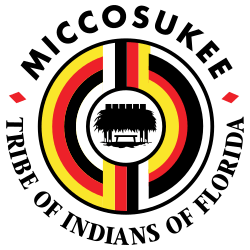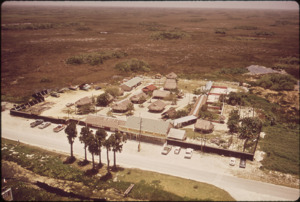Miccosukee facts for kids
 |
|
 |
|
| Total population | |
|---|---|
| 400 enrolled members (as of 1990s) | |
| Regions with significant populations | |
| Languages | |
| Mikasuki, English | |
| Religion | |
| Traditional tribal religion, Christianity | |
| Related ethnic groups | |
| Seminole (Seminole Nation of Oklahoma and Seminole Tribe of Florida), Creek |
The Miccosukee Tribe of Indians of Florida is a Native American tribe in the U.S. state of Florida. They were once part of the larger Seminole nation. In the mid-20th century, they became an independent tribe. The U.S. government officially recognized them in 1962.
The Miccosukee people speak the Mikasuki language. This language is very similar to the Hitchiti language. Many Florida Seminole people also speak Mikasuki.
Historically, the Miccosukee came from the Lower Chiaha tribe. The Chiaha were part of the Creek Confederacy in what is now Georgia. As European settlers moved into their lands, they moved to northern Florida in the early 1700s. There, they became part of the growing Seminole nation. By the late 1700s, the British called a Hitchiti-speaking group in the Florida Panhandle "Miccosukee." This group was centered around the village of Miccosukee, Florida.
Like other Seminole groups, the Miccosukee were forced to move during the Seminole Wars (1817–1858). Many were made to move west of the Mississippi River to Indian Territory in 1842. This happened after the Seminole Wars ended. The Miccosukee chief Ar-pi-uck-i, also known as Sam Jones, was a strong leader during the Second Seminole War.
The descendants of those who stayed in Florida lived mostly in the central part of the state. In the 1920s and 1930s, many Seminole built communities along the Tamiami Trail. This road was finished in 1928. It went through the Everglades and connected Tampa and Miami. These people were called the "Trail Indians." They often kept more traditional ways of life. They were less interested in working with the federal government. Other Seminole groups to the north began moving to reservations around the same time.
In 1953, the U.S. government planned to end its official relationship with the Seminole. The Seminole Tribe of Florida then organized as a tribe. They were recognized in 1957. This process showed the cultural differences between the groups. The Miccosukee gained state recognition separately in 1957. They received federal recognition in 1962. A third group, called Traditionals or Independents, did not join either tribe.
Contents
History of the Miccosukee
The Miccosukee people originally lived in the upper Tennessee Valley in Georgia. They were part of the Upper Chiaha tribe. Later, they split. The Miccosukee (Lower Chiaha) moved northeast to the Carolinas. The Upper Chiaha, also known as Muscogee, moved west to northern Alabama. As European-American settlers kept moving into their lands, many Miccosukee moved to northern Florida in the 1700s and 1800s.
The Lower Chiaha made up most of the Seminole tribe. This tribe formed in Florida in the 1700s. By the early 1800s, there were about 6,000 Seminole. About 2,000 Upper Creek (Red Sticks), who spoke Creek, joined them. This happened after they lost the Creek War of 1813-1814. Even though East and West Florida were controlled by Spain, the United States invaded in 1818. This was during the First Seminole War. It was done to stop Native American raids against settlers in Georgia.
In 1821, the United States (US) bought Florida from Spain. The US then pushed harder for the removal of the Seminole and Creek from Florida. Several thousand Seminole and hundreds of Black Seminoles were moved to the Indian Territory. They were first given land under Creek control. Later, they received their own separate reservation.
Those who stayed in Florida fought against US forces. This happened during the second and third Seminole Wars. They moved into central Florida and the Everglades. They hoped to avoid European-American settlers. During this time, the Miccosukee mixed with the Creek-speaking Seminole. However, many kept their Mikasuki language and their own identity.
From the 1900s to Today
The Miccosukee tribe had always kept its own identity. They felt different from the Seminole, who they thought were more open to changing their ways. The federal and state governments kept treating them as one group. There was also a third group, called Traditionals or Independents. One issue that divided them was a land claim filed by the majority Seminole in 1950. This claim asked for money for lands taken by the US government. The Miccosukee and Traditionals said they had never made a peace agreement with the US in Florida. They wanted their land back, not money.
In 1953, the government suggested ending its official recognition of the Seminole Tribe. The Seminole Tribe of Florida then created a constitution and a plan for their government. They gained federal recognition in 1957. These people had started moving to official reservations in Florida in the 1930s and 1940s.
The arguments over land claims and recognition made the "Trail People" more distinct. They began to organize as the Miccosukee Seminole Tribe. Most of them spoke the Mikasuki language. The state of Florida recognized them in 1957. They gained federal recognition in 1962 as the Miccosukee Tribe of Indians of Florida.
Today, the tribe lives on several reservations in southern Florida. These are known as the Miccosukee Indian Reservation. The largest part is a 333 333|acre|km2|adj=on reservation. It is on the northern edge of Everglades National Park, about 45 45|mi|km west of Miami. The tribe also controls about 200,000 200,000|acre|km2|adj=on of wetlands. Most of this land is under a long-term lease from 1983. They can use this land for hunting, fishing, frogging, and farming. This helps them keep their traditional Miccosukee way of life. Another area is their Alligator Alley Reservation, near Ft. Lauderdale. It has 20,000 20000|acre|km2|adj=on of land that can be developed. They use much of it for cattle grazing. It also has nearly 55,000 55000|acre|km2|adj=on of wetlands. They allow non-Natives to use some wetlands for hunting camps.
One of their lands is in Miami. In 1999, the tribe built the Miccosukee Resort & Conference Hotel there. This hotel includes gaming facilities. The money from this business helps with economic growth. It also improves education and welfare for the tribe. They have modern homes on their reservation west of Miami. Some tribal members also live in suburban Miami.
Miccosukee Membership
To become a Miccosukee member, a person must have at least half-Miccosukee ancestry. They also accept people with Miccosukee mothers who are not members of any other tribe. The tribe follows a matrilineal system for family ties and inheritance. This means children are considered part of their mother's clan. They get their status in the tribe from their mother's clan. In this system, the mother's older brother is very important to her children. He is often more important than the biological father, especially for boys. The uncle helps introduce the boys to the men's groups of the clan and tribe.
Miccosukee Government
The tribe has a written constitution. They elect leaders, including a chief. In 2015, Chief Colley Billie was removed from office. This was due to issues with managing money. As of 2020, the current chief is Billy Cypress. All adult members are part of the General Council. This council manages the tribe's services. The first chief when the tribe gained federal recognition was Buffalo Tiger. He continued to lead as tribal chairman until 1985.
The tribe has its own police and court system. They also have a clinic, a day care center, and a senior center. They run a Community Action Agency. They also have an education system. This system goes from the Head Start Pre-School Program through high school. Programs for adults, job training, and higher education are also available.
Business Interests
The tribe runs the 302-room Miccosukee Resort & Gaming hotel. This hotel is in Miami-Dade county.
The tribe has also sponsored several teams in NASCAR. These include Phoenix Racing and Billy Ballew Motorsports. They sponsored the 2009 Aaron's 499 winning Sprint Cup Series car driven by Brad Keselowski. They also sponsored a Camping World truck driven by Kyle Busch. And they sponsored a Nationwide car driven by Mike Bliss. The Miccosukee started their relationship with NASCAR in 2002. It ended before the 2010 season.
Miccosukee Museum
The Miccosukee Indian Village Museum opened in 1983. The museum shows visitors many types of art. These include native paintings, handmade crafts, and photographs. You can also see artifacts like cooking tools on display. The Museum is located at 41 Tamiami Trail, Miami, FL, 33131.
Education
Miccosukee Indian School is the tribe's own school.
Notable Miccosukee People
- Kinhagee: He was the last chief of the Creek of Miccosukee, Florida. US forces led by General Andrew Jackson defeated him in battle in 1818. Later, Kinhagee's people moved south. They kept their village name, Miccosukee, as the name of their tribe.
- Buffalo Tiger (Heenehatche): (1920–2015) He was the first chief of the Miccosukee Tribe of Indians of Florida. He led efforts for the tribe to make its own decisions.
See also
 In Spanish: Mikasuki para niños
In Spanish: Mikasuki para niños


